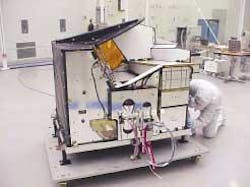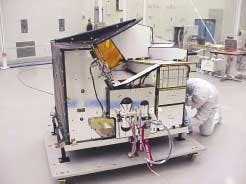Detector array looks at atmospheric limb
Extensive test and calibration is now complete on a spectroradiometer developed jointly by England and the United States that will be launched into space early next year. The High Resolution Dynamics Limb Sounder (HIRDLS) is among the instruments that will fly on NASA's new Earth Observing System Satellite, Aura, which is scheduled to be launched around January 2004 (see figure).1 Aura is a multi-instrument mission to study Earth's ozone, air quality, and climate by looking at the composition, chemistry, and dynamics of the upper and lower atmosphere. It will continue the observations made by NASA's Upper Atmosphere Research Satellite, which uncovered key processes leading to ozone depletion, and the Total Ozone Mapping Spectrometer, which has tracked global ozone changes over the last 22 years. Aura's objective is to take measurements with increased resolution and sensitivity over previous missions, and also to probe Earth's troposphere, the region of the atmosphere from the ground to about 10 km, which most affects our daily lives.
A limb sounder is a receiver that looks tangentially through the atmosphere. The HIRDLS instrument is an infrared limb sounder, a multichannel radiometer designed to analyze the upper troposphere, stratosphere, and mesosphere. It will determine temperature; the concentrations of ozone, water vapor, chlorinated fluorocarbons, methane, and nitrogen compounds, along with aerosols; and the locations of polar stratospheric clouds and cloud tops. The system is designed to provide sounding observations with horizontal and vertical resolution better than that previously obtained. It is hoped that the research will improve understanding of atmospheric processes, such as the exchange of ozone between the troposphere and stratosphere and the global distributions of aerosols.
Array of detectors
The High Resolution Dynamics Limb Sounder measures radiated thermal emissions from the atmospheric limb at a range of azimuth and elevation angles, measuring in the 8- to 100-km height range. The instrument measures at various spectral intervals between 6 and 18 µm using wavelengths chosen to correspond to specific target gases and atmospheric windows.
An array of 21 detectors is placed in the focal plane of a nonobscuring reflecting telescope, which has an entrance aperture with a diameter of 165 mm. Each detector element corresponds to an atmospheric field of 3.3 mrad (10 km at the tangent point in the atmosphere) horizontally by 0.33 mrad (1 km) vertically, along a 300-km line of sight. The photoconductive mercury cadmium telluride detectors are cooled to 65 K by a Stirling-cycle mechanical cooler; each detector has a separate bandpass interference filter. A chopper is placed at an intermediate focus of the telescope to modulate the incoming radiation, alternating between views to the atmosphere and to space. The telescope views the atmosphere via a two-axis tilting mirror which provides the necessary altitude and azimuth scanning; a multi-axis gyroscope module mounted on the optical bench provides accurate relative pointing knowledge.
Achieving the specifications of the HIRDLS system in space requires careful calibration and verification while the radiometer is still in the laboratory. An intensive program of testing was undertaken by the Atmospheric, Oceanic, and Planetary Physics Group at the University of Oxford (Oxford, England), which has the science leadership of the project jointly with the University of Colorado in Boulder (Boulder, CO), and is responsible for the calibration of the system. A dedicated laboratory was set up at the university to test the radiometric, spectral, and spatial response.
Building the appropriate test equipment required the production of very-high-specification optics. As part of the program, Optical Surfaces (Kenley, England), a manufacturer of high-precision optics for atmospheric and space research, supplied a large ultrasmooth off-axis paraboloid mirror of 1352-mm focal length and steep 15° off-axis angle. The mirror needed, and achieved, a uniform l/8 peak-to-valley finish at 633 nm across the surface of its 305-mm diameter. The mirror has been used to provide a reference wavefront to verify the performance of the HIRDLS optical-bench assembly and was part of a ground-based subassembly known as the collimator monochromator system (CMS). The CMS measured the instantaneous field of view and the spectral response of the instrument end-to-end.
REFERENCE
- http://eos-chem.gsfc.nasa.gov.

